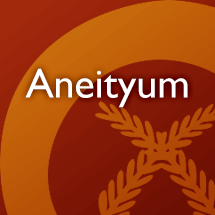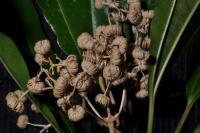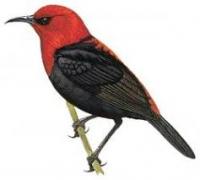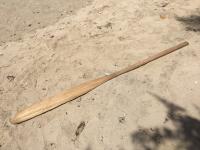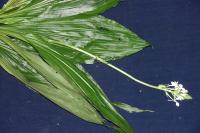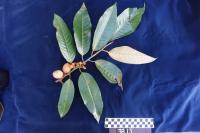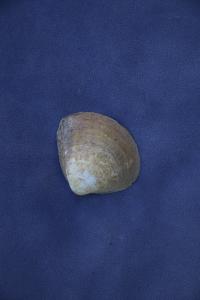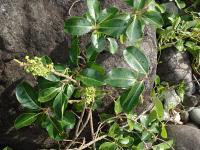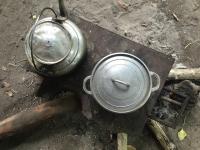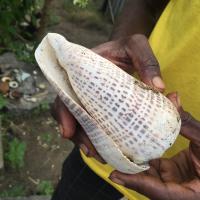An example search has returned 100 entries
elwa
v.
bookmarkemilmat
adj.
bookmarkereinmerei
n.
bookmarketti
v.
bookmarkincat
n.
bookmarkincei imtaig
n.
bookmarkincispev
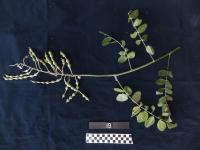
n.
Example: 1. To cure the sea snake (nispev) curse that causes missed periods. First the husband must combine 4 young leaves of incispev and 4 young leaves of nafanu and mash and squeeze the juice into a small bamboo (1-1.5 inch diameter) The nafanu is important because it is a plant that connects to the sea. Use wildcane leaves cover the bamboo closed. Go to the sick person and unwrap the snake from her. Start from the top and let the woman drink a small part of the potion then wash her with the mixture, making sure to wash head, elbows, knees, feet, and belly. Then take a leaf of naha and break it over the woman’s belly button to break the snake off. Smash the bamboo vessel to pieces. Leave the woman there until the wash dries on her. This takes one whole day and the ceremony in the evening so she can sleep and she must not eat. This ritual is performed by men.
bookmarkindawoc

inhetisjopoig
n.
bookmarkinhitilga

n.
Example: Rope is made from the inner bark of this plant. Use the rope immediately after it is stripped from the bark, there is no need to treat it with heat as is the case with other plants. Alternatively, the coil of bark rope can be kept in fresh water where it will stay soft until needed. Medicine for women when sick with a headache from the spirit sea snake, or sea god, or sea spirit that makes people sick. Men use it to help with toochaches. Women use it to help with backpain, stomache pain, or any other pain. Must pound two leaves taken from the top of the plant and combine with incespiv. Rosalina Nijae said it was mostly used by men so did not know how to use it well. Walking in bush and become thirsty, cut vine on 1 side and drink. Seeds made into foot bracelets for men for Kastom dances and make all sorts of different sounds. In some places taboo to cut large one as the large ones embody the snake spirit.
bookmarkinhosumeljag ~ nu inhosumeljag
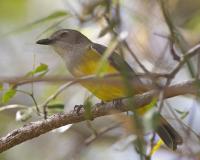
inhubej
n.
bookmarkinjedete anawanarin

inmaan
n.
bookmarkinmadidi

inmerisiahau
n.
bookmarkinmoijeuv natpoig
n.
bookmarkintak apnyin
n.
bookmarkintas
[intas]
bookmarkintinan tal
n.
bookmarkintop pa

n.
Example: This is an ornamental plant, grown around the home. People crush the leaves to enjoy the fragrance released. When bathing, grate coconut meat and crush the leaves of this plant and rub all over the body, before bathing and afterwards your body will smell very nice. To repel mosquitoes, crush these leaves and put them in the house.
bookmarkintop̃ hau
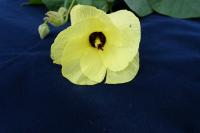
n.
Example: 1. Young shoots are peeled and made into grass skirts. Scrape the stem and take the green part off, tie strips together and put under stones in the sea for retting, let sit 5 days in sea, but check these on a daily basis. When the fiber becomes soft, that is the time to take it from under the stones, clean off the excess materials, and hang it in the sun to dry for 3 days--this will bleach it and give it a whitish color, at which point it can be woven into a skirt. 2. The fiber can be used to make a small rope that is tied with shells and used for custom dances. 3. When the stems of this tree are older, the wood is very hard and it can be used to make the main frame that is arched for a cyclone house. According to Reuben these houses are not made much anymore on Aneityum Island. 4. To cook the intestines of fish that are eaten, take several leaves and put them in a small pile, making a wrapping, then use a local fiber to tie this together and cook on charcoal for as long as needed to prepare the fish parts. 5. In this area, sometimes knowledge of the plants and flowering are used as a calendar to indicate the time for planting of specific crops. Reuben will provide more details on a future trip. 6a. This species is an important "message plant." If a person is not home and you are visiting from the East--e.g. an Eastern part of the Island--that person can leave a 12 inch piece of stick in front of the door of the house so that the inhabitant knows that an eastern visitor (from Anawonjei district) has come by your home. The reason that person has come to visit is to pass an important message to you--good or bad "luck". The bad luck message might be a death, and is not told directly to the person. The good luck message might be a birth, or conflict that has been resolved. These messages are communicated using sticks--each district has a different species of plant. Reuben’s is the hibiscus. 6b. Message plant for Eastern people. If someone dies, use this plant, clip it in front of hem, in front of home, they ask “who” and you can tell them. In Eastern culture you cannot tell them directly. 7. When a person is too drunk with kava, take a branch of this and brush him with it to help make the effects go away. 8. Traditional plates for food.
bookmarkinwaimeteuc
n.
bookmarkinyaratmas
n.
bookmarklopot lopot
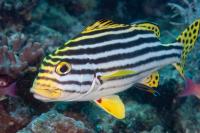
n.
Example: Photo by Mark Rosenstein / iNaturalist.org, License: CC BY-SA 3.0 via Fishes of Australia
bookmarkmaranapa
n.
bookmarkmure
adj.
bookmarknahi ateuc
n.
bookmarknahoijcei
n.
bookmarknakweiwei
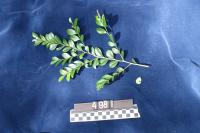
n.
Example: The wood is used to make a fishing spear. Cut the straight stems, heat it in fire, straighten it as much as needed, cool the stem, peel the bark off of the stem and let it cure for 1 month. In the past, the end of the spear was carved into a sharp point and used for fishing. Now steel rods are placed on the tip to catch the fish. This is used in shallow water (fresh water or sea water) as the wood is heavy and can sink. People making these spears go to older forests that are higher up to collect the wood.
bookmarknala

namlau elwa
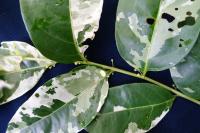
n.
Example: The wood of this tree is good for carving. The fibers go in one direction so it is easier to carve, for example, to make a kava bowl. In general, this is the species used to make kava bowls. If your kava is not strong, then making it in this bowl will make it stronger. The kind of bowl made from this tree has a handle on each side of the bowl and it is held with 2 hands. The place name Anumwmamlau is named after this tree. There are said to be two types of this tree--one with all green leaves (this specimen) and one with white and green leaves. If a person is going to a Tabu place and is concerned about spirits, they should take a handful of these leaves and wash the body all over with it--take a swim (bath) with it. Then the person can go to the Tabu place without risk. There are other unspecified spiritual uses of this tree. The second part of this local name "elwa" refers to the variegation of the leaves.
bookmarknapaeicei
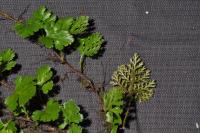
nap̃od
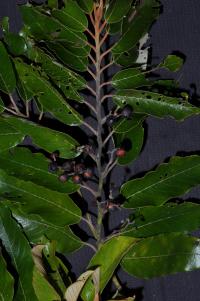
nariko cei
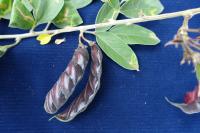
n.
Example: 1a. Cultivated in gardens. Cook seeds of this species or eat them raw before they are fully ripened. The green pods can also be cooked in a fire and eaten. 1b. Cultivated plant for its edible seeds, can be prepared in a pot of bamboo. OR could take branches w/ seeds and put directly on the earth oven for cooking. 2. Planting this species adds nitrogen to the soil--grow it on soil that is said to be "tired."
bookmarknatora
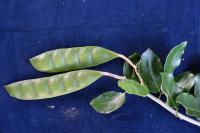
nau-hos
n.
Example: Used to build walls of local houses. The outer skin is stripped off, stems cut in half then smashed flat, the inside is stripped clean and woven into walls. The cut pieces of entire stems can be filled with food and used for cooking that food. Cover both ends with leaves and cook. If a person has skin that becomes infected, use sharpened stem as a local knife to remove the infected area of skin. Use as a local water pipe to move water from one place to another (nobol). Either split the stem in half or punch the nodes out throughout the entire tube and use as a pipe.
bookmarknaupitju
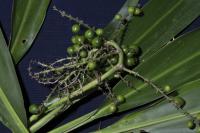
n.
Example: People use the leaf of this plant to tie over grated banana, taro or other foods for cooking in an earth oven or boiling in a pot. The root of this species is edible. Cook it for 2-3 nights in an earth oven and then chew and squeeze the juice into your mouth, spitting out the fiber.
bookmarknauyerop̃
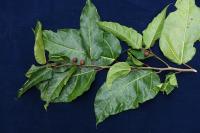
n.
Example: 1. To cure spirit sickness of the niteitau. Use plants that also end with "au" : niditau, intoutau, naoyerop. Go to the top of the plant to get the soft leaves of the plants niditau, intoutau, naoyerop, also take the bark. The person making the medicine should be holding the these leaves with a piece of nelmaha. Nelmaha means go away. The sick person chews the leaves and bark and swallows the juice spitting out the fiber into the nelmaha the medicine maker is holding. The medicine person then takes the spit out fiber in the nalmaha leaf and throws it into the sea in front of the village. 2. Edible fruits, when ripe or green, does not taste when green, but sweet when ripe. 3a. Leaves (young) are edible, for example wrap around coconut meat and eat or cook with island cabbage and other leaves, boil and add coconut milk and eat. 3b. The young leaves are edible, after boiling for 5 minutes. A piece of coconut and a pinch of salt is wrapped in the leaves and eaten. The mature leaves are used to wrap food such as pig or cow meat and cooked in an earth oven. Tie this bundle with a piece of Pandanus fiber to secure it before putting in the earth oven. 4. During big feast, use this a lot – circumcison or wedding feast, harvest leaves and wrap around meat and bake on earth oven – sometimes we cut down a whole tree to gather leaves. 5. To make men’s custom belt – split stem, peel outer bark off to take inner bark and peel it, tear end to make strap that can be tied. Dry in sun but not direct sunlight. 6. Older large trunks were burned by ancestors to keep fire going – did not need matches (lefre(?) matches) because embers would stay for days and when make a fire add smaller branches to make a flame.
bookmarknejoplec

neroa
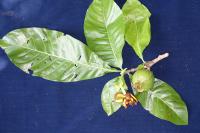
n.
Example: 1. The flower is used to make a necklace and the wood used as poles for a house roof. The flower is very fragrant and people put it behind their ear to enjoy the aroma. The leaf is used to bake taro in the earth oven. Use a fire to heat stones, then when the fire burns down and the stones are hot, pile these leaves on top of the hot stones and then place the food being cooked--taro, fish, pig, cassava, banana or other foods--on top of the leaves. Then pile more of these leaves on top of the food and then place additional hot stones on top of that pile of leaves. While the food is cooking--each type of food takes a different amount of time--the leaves give off a very nice smell and help flavor the food. 2. Firewood, flower smells good, put in coconut oil to give it aroma. Grate coconut, add small amount of water, put in bowl, heat until water is evaporated, the oil is on top, take all the coconut cream on bottom save oil in another pot. Drop 2-3 flowers into coconut oil and boil, or more flowers. Try not to burn the oil. Take out flowers and use pure oil. Also used for final covering of large earth oven during feast along with GMP 3503 – esp. wedding feast. Planting pole and hard and heavy wood – sharp end. 3. This is a "calendar plant." When it flowers, people know that the taro is ready to harvest.
bookmarknetcetec
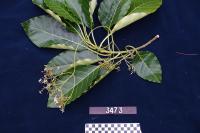
nidi yebeg
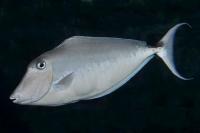
n.
Example: Photo by Ross D. Robertson / Shorefishes of the Neotropics, License: CC BY-SA 3.0 via Fishes of Australia
bookmarknidiape
n.
bookmarknihivaeñ aeyec
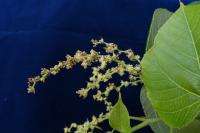
n.
Example: 1. When a person has a headache from being out in the sun too long, scrape the outer bark off of the stem of this tree, take scrapings of the inner bark, wrap with a leaf of breadfruit and put in a fire for 15-20 minutes. Not a hot fire, but only in the flame. Squeeze the water out of the bark when it is warm and rub all over the forehead and face to help the headache go away. 2. Use the stems of this tree as a stick to carry taro from the field, as the stick is strong but not too heavy. The taro is tied to each end to balance on a person’s shoulders. 3. Leaf used for wrapping local medicines. This is the best leaf and put it on the charcoal to heat it. 4. Good firewood.
bookmarknillum
n.
bookmarknilupau
n.
bookmarknipjid aiyu
n.
bookmarknitet
n.
bookmarknohmun wai
n.
bookmarknowat
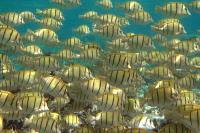
n.
Example: Photo by Philippe Bourjon / Fishbase, License: CC BY-SA 3.0 via Fishes of Australia
bookmarknucije
n.
bookmarkrap̃ad
[rak͡pad] n.
bookmarksepam
adv.
bookmarksimi
adv.
bookmarktarere
adv.
bookmarkugnis
v.a.
bookmarkugnyiv
adj.
bookmarkuleme
adj.
bookmark